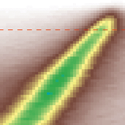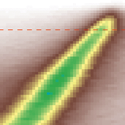Shining light on corrugated graphene
Graphene is often described as a perfectly flat, two-dimensional sheet of carbon. Yet when freely suspended, it is known to deform with ripples and corrugations. This local curvature renders angle-resolved photoemission spectroscopy (ARPES), a standard technique for probing a material’s electronic structure, ineffective. In ARPES, the energy and momenta of photo-excited electrons are detected as they are emitted from the surface of a material, but this surface needs to be atomically flat so that momentum perpendicular to the surface is conserved. Also, because monolayer graphene is so thin, the substrate over which it is suspended can contribute a large background signal.
Now, in an article appearing in Physical Review B, Kevin Knox at Columbia University, New York, and his collaborators have circumvented these challenges and used ARPES to measure the electronic structure of a corrugated sheet of freely suspended graphene. Knox et al. employ a low-energy electron microscope that can provide real-space information about the corrugations as well as bandstructure information via photoemission measurements. With a map of the surface morphology, Knox et al. can distinguish the broadening of the ARPES spectrum due to corrugations from that due to the intrinsic lifetime of the quasiparticles. According to their measurements, electrons in suspended graphene still have a linear relationship between energy and momentum, and the lifetime of quasiparticles scales inversely with their energy. The group’s techniques are likely to be useful for probing the effects of structural distortions in a variety of 2D systems. – Sarma Kancharla





